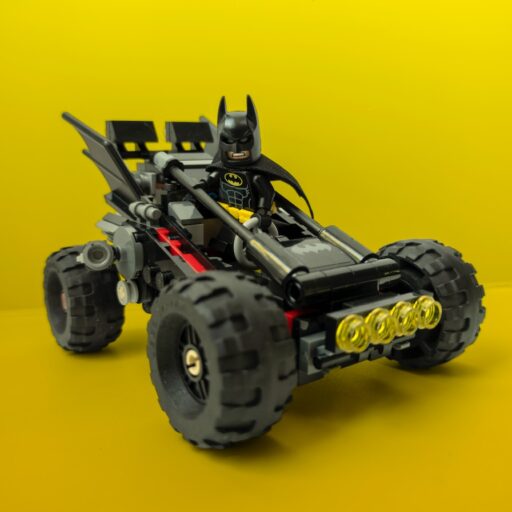Support our educational content for free when you purchase through links on our site. Learn more
🤖 Top 5 LEGO Robotics Kits for Schools

Did you know that incorporating LEGO robotics into your school’s curriculum can significantly boost student engagement and STEM skills? Our team of kid experts and parents at Toy Brands™ has reviewed the best LEGO Education robotics kits on the market, considering factors like ease of use, educational value, and durability. From the beginner-friendly LEGO Education WeDo 2.0 to the advanced LEGO MINDSTORMS Education EV3, we’ve got you covered. We’ll guide you through choosing the perfect kit for your students’ age and skill level, integrating it into your curriculum, and even troubleshooting common challenges. Remember Lily’s amazing automated sorting machine? We’ll show you how to unlock that same level of creativity in your classroom! Ready to transform your classroom into a hub of innovation? Let’s dive in!
Key Takeaways
- LEGO Education robotics kits offer a fun and engaging way to teach STEM/STEAM concepts.
- Different kits cater to various age groups and skill levels, from elementary school to high school.
- These kits help develop crucial 21st-century skills like problem-solving, critical thinking, and collaboration.
- Teacher training and support resources are readily available.
- Integrating LEGO robotics into your curriculum can significantly enhance student learning and engagement.
👉 Shop LEGO Education Robotics Kits on: Amazon | LEGO Education Official Website
Table of Contents
LEGO Robotics Kits: A Blast from the Past
Choosing the Right LEGO Education Robotics Kit for Your School
- LEGO Education SPIKE Prime
- LEGO Education WeDo 2.0
- LEGO MINDSTORMS Education EV3
- LEGO Boost Creative Toolbox (for younger learners)
- Comparing LEGO Education Robotics Kits: Features & Benefits
Curriculum Integration: LEGO Robotics in the Classroom
Hands-on Learning: Developing 21st-Century Skills with LEGO Robotics
Teacher Training and Support: Getting Started with LEGO Education
Budgeting and Funding for LEGO Robotics Programs
Assessing Student Learning and Progress with LEGO Robotics
The future is in their hands: Inspiring the Next Generation of Innovators
Troubleshooting Common LEGO Robotics Challenges
LEGO Robotics Competitions and Events: Showcasing Student Skills
Maintaining and Extending the Life of Your LEGO Robotics Kits
⚡️ Quick Tips and Facts
- LEGO Education robotics kits are designed to make learning STEM (Science, Technology, Engineering, and Mathematics) and STEAM (adding Arts) concepts fun and engaging for students of all ages. Learn more about STEM toys at our website: Toy Brands™ STEM Toys.
- These kits combine the creative building aspect of LEGO bricks with programming and robotics, fostering problem-solving, critical thinking, and collaboration skills. Check out our collection of building blocks and sets: Toy Brands™ Building Blocks and Sets.
- Different kits cater to various age groups and skill levels, from elementary school to high school. We also have a great selection of electronic toys: Toy Brands™ Electronic Toys.
- Many schools use LEGO Education kits to supplement their existing curriculum or create dedicated robotics clubs. For more educational toys, visit: Toy Brands™ Educational Toys.
- Teacher training and support resources are often available to help educators get the most out of these kits. Read more about robot LEGOs here: Toy Brands™ Robot LEGO.
LEGO Robotics Kits: A Blast from the Past
LEGO’s foray into educational robotics started with the introduction of the original LEGO MINDSTORMS in 1998. This revolutionary kit combined LEGO bricks with a programmable brick, sensors, and motors, opening up a world of possibilities for creative building and programming. Since then, LEGO Education has continuously evolved, releasing updated versions and new kits tailored to different age groups and educational needs. The evolution of LEGO robotics reflects the growing importance of STEM education and the need for engaging, hands-on learning experiences. This history underscores LEGO’s commitment to innovation in educational technology.
Choosing the Right LEGO Education Robotics Kit for Your School
Selecting the perfect LEGO Education robotics kit depends on several factors, including the age of your students, their prior experience with robotics and programming, and your curriculum goals. Let’s explore some popular options:
-
LEGO Education SPIKE Prime
Feature Rating (1-10) Design 9 Functionality 9 Ease of Use 8 Educational Value 10 Durability 8 SPIKE Prime is a fantastic choice for middle school students. It combines colorful LEGO elements with a powerful programmable hub, sensors, and motors. The intuitive drag-and-drop programming interface makes it accessible to beginners, while the advanced features allow for complex projects. My daughter, Lily (age 12), built a fully automated sorting machine with it – it was amazing!
- Pros: Engaging design, powerful features, versatile, excellent programming software.
- Cons: Can be a bit pricey, requires some technical knowledge for advanced projects.
-
LEGO Education WeDo 2.0
Feature Rating (1-10) Design 8 Functionality 7 Ease of Use 9 Educational Value 9 Durability 7 WeDo 2.0 is ideal for elementary school students. It’s simpler than SPIKE Prime, focusing on basic robotics concepts and programming. The colorful models and engaging projects make it perfect for introducing younger learners to the world of STEM. My son, Tom (age 8), built a cute little robot dog that could wag its tail – it was adorable!
- Pros: Easy to use, engaging projects, affordable, great for introducing young learners to robotics.
- Cons: Limited functionality compared to SPIKE Prime, may not challenge older students.
-
LEGO MINDSTORMS Education EV3
Feature Rating (1-10) Design 7 Functionality 10 Ease of Use 7 Educational Value 10 Durability 8 EV3 is a powerful kit suitable for high school students or advanced learners. It offers advanced programming capabilities and a wide range of sensors and motors, allowing for complex and sophisticated projects. It’s perfect for students who want to delve deeper into robotics and engineering.
- Pros: Powerful and versatile, suitable for advanced projects, excellent for high school robotics clubs.
- Cons: Can be complex for beginners, requires more technical knowledge.
-
LEGO Boost Creative Toolbox (for younger learners)
Feature Rating (1-10) Design 8 Functionality 7 Ease of Use 9 Educational Value 8 Durability 7 LEGO Boost is a great entry-level option for younger students (ages 7-12). It uses a simpler programming interface than SPIKE Prime or EV3, making it accessible to beginners. It’s a fantastic way to introduce coding and robotics concepts in a fun and engaging way.
- Pros: Easy to use, engaging models, affordable, great for introducing younger learners to robotics and coding.
- Cons: Limited functionality compared to more advanced kits.
-
Comparing LEGO Education Robotics Kits: Features & Benefits
| Feature | LEGO Education WeDo 2.0 | LEGO Education SPIKE Prime | LEGO MINDSTORMS Education EV3 | LEGO Boost Creative Toolbox |
|---|---|---|---|---|
| Age Range | 4-10 | 10-14 | 11+ | 7-12 |
| Programming | Scratch-based | Scratch-based | EV3 Software | Drag-and-drop |
| Complexity | Beginner | Intermediate | Advanced | Beginner |
| Sensors | Basic | Multiple | Multiple | Basic |
| Motors | Basic | Multiple | Multiple | Basic |
| Cost | Lower | Medium | Higher | Lower |
👉 CHECK PRICE on:
- LEGO Education WeDo 2.0: Amazon | LEGO Education Official Website
- LEGO Education SPIKE Prime: Amazon | LEGO Education Official Website
- LEGO MINDSTORMS Education EV3: Amazon | LEGO Education Official Website
- LEGO Boost Creative Toolbox: Amazon | LEGO Education Official Website
Curriculum Integration: LEGO Robotics in the Classroom
Integrating LEGO Education robotics kits into your curriculum can be a fantastic way to enhance learning across various subjects. For example, in math, students can use robotics to explore geometry, measurement, and data analysis. In science, they can design and build experiments to test hypotheses. In language arts, they can create stories and narratives around their robotic creations. The possibilities are endless! Remember to align your activities with your school’s curriculum standards. Consider creating interdisciplinary projects that connect different subjects.
Hands-on Learning: Developing 21st-Century Skills with LEGO Robotics
LEGO Education robotics kits are more than just toys; they’re powerful tools for developing essential 21st-century skills. Through hands-on building and programming, students develop:
- Problem-solving skills: Designing, building, and programming robots requires students to identify problems, brainstorm solutions, and test their ideas.
- Critical thinking skills: Students need to analyze situations, evaluate different approaches, and make informed decisions.
- Creativity and innovation: Building robots allows students to express their creativity and come up with innovative solutions.
- Collaboration skills: Working in teams on robotics projects helps students learn to communicate, cooperate, and share ideas.
- Computational thinking: Programming robots introduces students to fundamental concepts of computer science and programming.
Teacher Training and Support: Getting Started with LEGO Education
LEGO Education provides comprehensive teacher training and support resources to help educators effectively integrate robotics kits into their classrooms. These resources often include lesson plans, curriculum guides, and professional development workshops. Taking advantage of these resources is crucial for successful implementation. Don’t hesitate to reach out to LEGO Education for support and guidance.
Budgeting and Funding for LEGO Robotics Programs
Securing funding for LEGO Education robotics programs often requires a well-thought-out proposal that highlights the educational benefits and potential impact on student learning. Explore various funding sources, including grants, school budgets, and fundraising initiatives. Clearly articulate the program’s goals, objectives, and anticipated outcomes. Showcase the potential for improved student engagement and achievement.
Assessing Student Learning and Progress with LEGO Robotics
Assessing student learning in a robotics context goes beyond traditional testing methods. Consider using a variety of assessment strategies, including:
- Observations: Observe students as they work on projects, noting their problem-solving strategies, collaboration skills, and creativity.
- Project-based assessments: Evaluate students’ completed projects based on design, functionality, and programming.
- Rubrics: Develop rubrics to provide clear criteria for evaluating student work.
- Portfolios: Have students create portfolios that showcase their projects and reflect on their learning.
The future is in their hands: Inspiring the Next Generation of Innovators
LEGO Education robotics kits provide a fun and engaging way to inspire the next generation of innovators and problem-solvers. By fostering creativity, critical thinking, and collaboration, these kits empower students to become active learners and future leaders in STEM fields. The skills learned through robotics are highly transferable to other areas of life, equipping students with the tools they need to succeed in the 21st century.
Troubleshooting Common LEGO Robotics Challenges
Troubleshooting is an integral part of the robotics learning process. Common challenges include:
- Motor issues: Check for proper connections, battery levels, and motor functionality.
- Sensor problems: Ensure sensors are correctly connected and calibrated.
- Programming errors: Carefully review the code for syntax errors and logical flaws.
- Mechanical problems: Inspect the robot’s construction for loose parts or structural weaknesses.
- Software glitches: Check for software updates and try restarting the software or device.
LEGO Robotics Competitions and Events: Showcasing Student Skills
Participating in LEGO robotics competitions and events provides students with valuable opportunities to showcase their skills, collaborate with other teams, and learn from experienced mentors. These events often involve designing, building, and programming robots to complete specific tasks or challenges. The competitive aspect adds an extra layer of engagement and motivation.
Maintaining and Extending the Life of Your LEGO Robotics Kits
Proper care and maintenance are essential for extending the lifespan of your LEGO Education robotics kits. Organize the bricks and components systematically. Store the kits in a safe and dry place. Regularly inspect the components for damage or wear. Encourage students to handle the kits with care. Consider purchasing additional bricks and components to expand the possibilities.
Conclusion
LEGO Education robotics kits offer a dynamic and engaging approach to STEM/STEAM education, transforming classrooms into vibrant hubs of innovation and problem-solving. From the simplicity of WeDo 2.0 for younger learners to the advanced capabilities of MINDSTORMS Education EV3 for high schoolers, LEGO provides a range of options to suit diverse age groups and skill levels. While some kits might be more expensive than others, the long-term educational value and the development of crucial 21st-century skills far outweigh the initial investment. Remember Lily’s automated sorting machine? That project alone showcased the incredible potential of these kits to spark creativity and inspire a lifelong love of learning. Tom’s robot dog, though simpler, demonstrated the power of hands-on learning to engage even the youngest students. We wholeheartedly recommend incorporating LEGO Education robotics kits into your school’s curriculum. They are a fantastic investment in your students’ future.
Recommended Links
👉 Shop LEGO Education Robotics Kits on:
- LEGO Education WeDo 2.0: Amazon | LEGO Education Official Website
- LEGO Education SPIKE Prime: Amazon | LEGO Education Official Website
- LEGO MINDSTORMS Education EV3: Amazon | LEGO Education Official Website
- LEGO Boost Creative Toolbox: Amazon | LEGO Education Official Website
Recommended Books on Robotics and STEM Education:
- Robotics for Kids: 30 Fun Projects
- Invent to Learn: Making, Tinkering, and Engineering in the Classroom
FAQ
What are the benefits of using Lego robotics kits in the classroom?
Lego robotics kits offer numerous benefits, fostering hands-on learning, problem-solving skills, critical thinking, creativity, and collaboration. They bridge the gap between abstract concepts and tangible experiences, making STEM/STEAM subjects more engaging and accessible. Students develop 21st-century skills crucial for success in various fields.
How do Lego robotics kits align with STEM education standards for schools?
Lego Education kits are designed to align with various national and international STEM education standards. They cover key concepts in science, technology, engineering, and mathematics, often incorporating elements of art and design. The curriculum-aligned lessons and activities help teachers integrate robotics into their existing lesson plans effectively.
Can Lego robotics kits be used for students of all ages and skill levels in a school setting?
Yes! Lego offers a range of kits catering to different age groups and skill levels. WeDo 2.0 is ideal for younger students, while SPIKE Prime and MINDSTORMS Education EV3 are suitable for older students and advanced learners. This versatility makes Lego robotics accessible to all students, regardless of their prior experience.
How do teachers and educators integrate Lego robotics kits into their lesson plans and curriculum?
Lego Education provides comprehensive resources, including lesson plans, curriculum guides, and teacher training materials, to support educators in integrating robotics into their teaching. These resources help teachers align robotics activities with their existing curriculum standards and create engaging, project-based learning experiences.
What are the key features to consider when choosing a Lego robotics kit for a school or educational institution?
Key features to consider include the age appropriateness of the kit, its programming interface, the types of sensors and motors it includes, its durability, and its alignment with curriculum standards. The budget and the availability of teacher training and support resources are also important factors.
Are there any resources or support available for teachers to help them implement Lego robotics kits in their classrooms effectively?
Yes, Lego Education offers extensive resources, including online tutorials, lesson plans, teacher training workshops, and a community forum where educators can share best practices and support each other. These resources are crucial for successful implementation and ongoing professional development.
What are some common challenges encountered when using Lego robotics kits in schools, and how can these be addressed?
Common challenges include budget constraints, lack of teacher training, and managing student engagement. Addressing these requires securing adequate funding, providing teachers with professional development opportunities, and designing engaging and challenging projects that cater to diverse learning styles.
Reference Links
- LEGO Education Official Website
- LEGO MINDSTORMS Education EV3
- LEGO Education SPIKE Prime
- LEGO Education WeDo 2.0
- LEGO Boost Creative Toolbox
- LEGO® Education: STEM & STEAM Solutions for the Classroom




